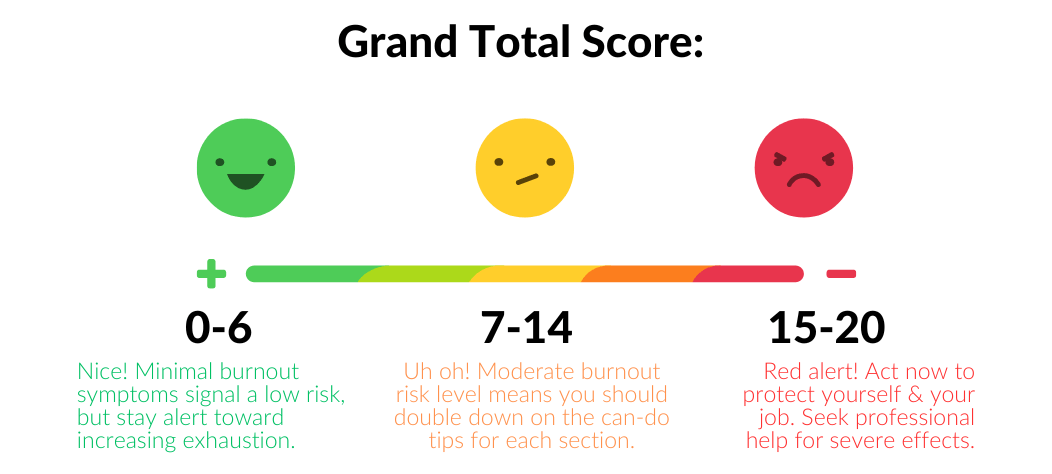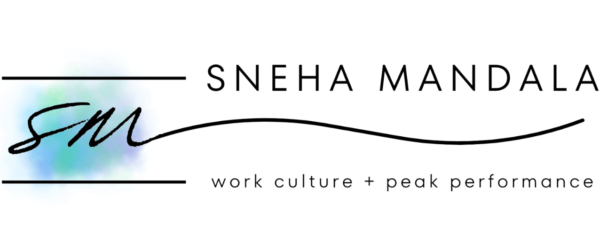STOP. If you haven’t taken the test already, access it here.
Ready with your section scores? Scroll down to analyze which burnout stage you are in based on your scores:
SECTION 1 / STAGE 1: Inner State
(Earliest Signs of Burnout Within)
Your score is 0 – 4 (Low to Moderate Risk):
- What’s Happening: You may be experiencing early signs of burnout, such as fatigue, irritability, or lack of motivation. These symptoms may not yet significantly impact your interactions at work or your overall productivity.
- If This Goes Unchecked: If left unaddressed, these early signs of burnout may escalate, leading to increased stress and disengagement. You might struggle to cope with work demands, lash out on colleagues, and may experience a decline in overall well-being.
- What You Can Do: It’s essential to recognize these early signs of burnout and take proactive steps to address them. This may include prioritizing self-care, setting boundaries, and seeking support from colleagues or mental health professionals.
Your score is 5- 8 (High Risk):
- What’s Happening: You are experiencing considerable symptoms of burnout, including heightened stress levels, decreased job satisfaction, and emotional exhaustion. These symptoms may begin to impact your interactions at work and your overall performance.
- If This Goes Unchecked: If left unaddressed, these moderate symptoms of burnout can lead to further disengagement, conflicts with colleagues, and decreased productivity. You might find it challenging to maintain motivation and may be at risk of developing more severe burnout.
- What You Can Do: It’s crucial for you to take proactive steps to manage your stress and prioritize your well-being. This may involve seeking support from supervisors or HR, practicing stress-management techniques, and considering adjustments to workload or responsibilities as soon as you can.
SECTION 2 / STAGE 2: Interactions
(Your Burnout Starts Affecting Others)
Your score is 0 – 3 (Low to Moderate Risk):
- What’s Happening: You may be experiencing minimal impact on your interactions at work due to burnout symptoms. You may still be able to maintain professional relationships and collaborate with colleagues effectively.
- If This Goes Unchecked: If left unaddressed, even minimal impact on interactions can escalate, leading to strained relationships, conflicts with colleagues, and decreased teamwork. You might feel isolated and unsupported, further exacerbating your burnout symptoms.
- What You Can Do: It’s important for you to recognize the early signs of strain on your interactions and take steps to address them. This may involve communication with colleagues about workload or stressors, setting boundaries, and seeking support from supervisors or HR.
Your score is 4 – 6 (High Risk):
- What’s Happening: You are experiencing significant impact on your interactions at work due to burnout symptoms. You may find it challenging to communicate effectively, collaborate with colleagues, or maintain professional boundaries.
- If This Goes Unchecked: If left unaddressed, these moderate impacts on interactions can escalate, leading to increased conflicts, decreased teamwork, and a negative work environment. You might feel disconnected from your colleagues and struggle to find support.
- What You Can Do: You should prioritize open communication and seek support from colleagues or supervisors to address any challenges you may be facing. Building strong relationships and maintaining boundaries can help mitigate the impact of burnout on interactions at work.
SECTION 3 / STAGE 3: Inefficiency
(Your Burnout Impacts Your Work Itself)
Your score is 0 – 3 (Low to Moderate Risk):
- What’s Happening: You may be experiencing minimal impact on your work tasks and performance due to burnout symptoms. You may still be able to meet deadlines and fulfill your responsibilities, albeit with some difficulty.
- If This Goes Unchecked: If left unaddressed, even minimal impact on work tasks can escalate, leading to decreased productivity, errors or mistakes, and missed deadlines. You might struggle to maintain the quality of your work and may be at risk of burnout-related consequences.
- What You Can Do: It’s essential for you to recognize any early signs of decreased performance and take proactive steps to address them. This may involve prioritizing tasks, seeking support from colleagues or supervisors, and considering adjustments to workload or deadlines.
Your Score is 4 – 6 (High Risk):
- What’s Happening: You are experiencing some impact on your work tasks and performance due to burnout symptoms. You may find it challenging to meet deadlines, maintain focus, or perform at your usual level.
- If This Goes Unchecked: If left unaddressed, these moderate impacts on work tasks can escalate, leading to decreased efficiency, increased errors or mistakes, and a decline in overall job performance. You might struggle to keep up with workload demands and may be at risk of burnout-related consequences.
- What You Can Do: You should prioritize self-assessment and seek support to address any challenges you may be facing in your work tasks. This may involve delegating tasks, setting realistic goals, and practicing self-care to mitigate the impact of burnout on work performance.





